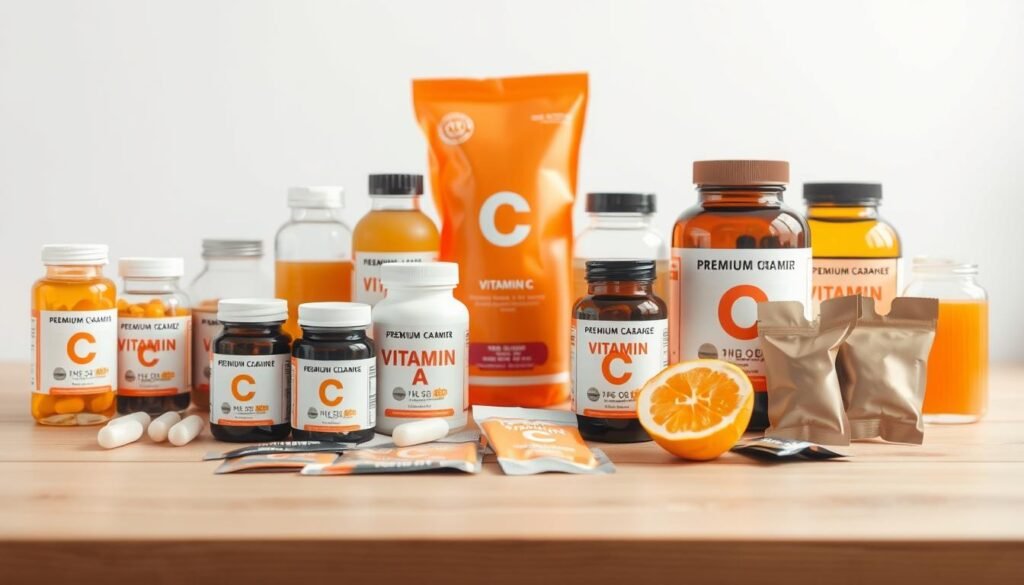The concept of taking high doses of vitamin C has been around since the 1970s, when Linus Pauling first researched its potential benefits. Recently, the interest in vitamin C mega-dosing has seen a significant surge, sparking a revolution in nutritional research.
As more people discover the benefits of vitamin C for immune system support and overall health, the vitamin C revolution is gaining momentum. The potential applications of mega-dosing are vast, and researchers continue to explore its effects.
With the rise of this trend, understanding the science behind mega doses and their impact is crucial. This section will delve into the history and current state of vitamin C mega-dosing.
Key Takeaways
- Vitamin C mega-dosing has been researched since the 1970s.
- The vitamin C revolution is gaining momentum.
- Mega doses have potential applications in health.
- Researchers continue to explore the effects of high-dose vitamin C.
- Understanding the science behind mega doses is crucial.
The Rise of Vitamin C Mega-Dosing
The concept of vitamin C mega-dosing has revolutionized the way we approach health optimization. Traditionally, vitamin C was primarily known for its role in preventing scurvy, a disease caused by its deficiency. However, recent research and clinical practice have shifted the focus towards using high doses of vitamin C to achieve optimal health and boost the immune system.
From Scurvy Prevention to Health Optimization
The work of Dr. Robert Cathcart on bowel tolerance and vitamin C mega-dosing has been particularly influential. By understanding how high doses of vitamin C can be used to achieve optimal health, individuals can make informed decisions about incorporating it into their health regimen. This approach has shown promise in enhancing overall well-being and providing an immune system boost.
Defining “Mega Dose” in the Vitamin C Context
In the context of vitamin C, a “mega dose” typically refers to amounts significantly higher than the recommended daily allowance. These doses are often used to harness the antioxidant power of vitamin C, which can help protect cells from damage and support overall health. By understanding what constitutes a mega dose, individuals can better navigate the complex landscape of vitamin C supplementation.
The Science Behind Mega Doses, Mega Impact: The Vitamin C Revolution
Understanding the mechanisms behind vitamin C mega-dosing is crucial for appreciating its impact on health. The science behind high-dose vitamin C supplementation involves complex biochemical processes that affect various bodily functions.
How High-Dose Vitamin C Works in the Body
When taken in mega doses, vitamin C exhibits antioxidant power that can neutralize free radicals, potentially enhancing immune function and overall well-being. Research has shown that high levels of vitamin C can be achieved through supplementation, far exceeding what is possible through diet alone.
Differences Between Regular and Therapeutic Doses
The distinction between regular and therapeutic doses of vitamin C lies in their effects on the body. While regular doses may prevent deficiency, therapeutic doses are used to achieve specific health benefits. Studies in vitamin c research have highlighted the potential of mega dose supplements to saturate cells, potentially leading to enhanced immune response and other beneficial effects.
Cellular Saturation Points
An important concept in understanding the effects of high-dose vitamin C is the idea of cellular saturation points. Once cells are saturated with vitamin C, additional supplementation may not yield further benefits. Understanding this concept is key to optimizing mega dose supplements for health benefits.
In conclusion, the science behind vitamin C mega-dosing reveals a complex interplay of biochemical processes that can have significant health implications. By understanding how high-dose vitamin C works in the body and the differences between regular and therapeutic doses, individuals can make informed decisions about their supplementation regimen.
Historical Perspective: Linus Pauling’s Pioneering Research
Linus Pauling’s groundbreaking research on vitamin C laid the foundation for the current vitamin C revolution. As a two-time Nobel laureate, Pauling’s work carried significant weight, though some of his claims about vitamin C benefits were considered controversial at the time.
The Nobel Laureate’s Controversial Claims
Pauling advocated for the use of high dose vitamin C for preventing and treating various conditions, including the common cold and cancer. His assertions were met with skepticism by the medical community, who questioned the validity of his research methods and conclusions.
Modern Validation of Pauling’s Theories
Recent studies have revisited Pauling’s theories, providing some validation for his claims. Research has shown that high dose vitamin C can have significant health benefits, including enhanced immune function and antioxidant effects.
Evolution of Scientific Acceptance
Over time, the scientific community’s acceptance of Pauling’s work has evolved. While initial reactions were mixed, ongoing research has contributed to a greater understanding of vitamin C benefits, leading to increased acceptance of some of Pauling’s ideas. This shift has contributed to the ongoing vitamin C revolution, with more people exploring the potential of high-dose vitamin C for health optimization.
Immune System Supercharging with High-Dose Vitamin C
Recent studies have highlighted the role of high-dose vitamin C in supercharging the immune system. The potential of vitamin C to support immune health has been a subject of research, particularly in the context of its effects on white blood cell function, common illnesses, and its relevance to recent global health challenges.
Enhancing White Blood Cell Function
White blood cells are crucial for fighting infections. High-dose vitamin C has been shown to enhance the function of these cells, potentially leading to a more robust immune response. Research indicates that vitamin C can improve the production and activity of white blood cells, which are vital for combating pathogens.
Reducing Duration and Severity of Common Illnesses
Vitamin C’s role in reducing the duration and severity of common colds and flu has been well-documented. Regular intake of high-dose vitamin C can lead to fewer days of illness and reduced symptom severity, making it a valuable supplement for overall health.
COVID-19 and Recent Vitamin C Research
The COVID-19 pandemic has accelerated research into the potential benefits of high-dose vitamin C in managing viral infections. Studies have explored its use in critically ill patients, showing promising results in reducing mortality and improving outcomes.
The key benefits of high-dose vitamin C for immune system support include:
- Enhanced white blood cell function
- Reduced severity and duration of common illnesses
- Potential benefits in managing COVID-19
In conclusion, high-dose vitamin C presents a compelling case for immune system support, backed by emerging research and potential therapeutic applications.
Beyond Immunity: Lesser-Known Benefits of Vitamin C Mega-Dosing
While many know vitamin C for its immune-boosting properties, its mega-dosing benefits extend far beyond immunity. Research has uncovered a range of additional advantages, from cardiovascular health improvements to enhanced cognitive function.
Cardiovascular Health Improvements
Vitamin C mega-dosing has been shown to support heart health by improving endothelial function and reducing blood pressure. High-dose vitamin C can help mitigate oxidative stress, a key factor in cardiovascular disease.
Cognitive Function Enhancement
Emerging evidence suggests that high-dose vitamin C may have neuroprotective effects, potentially improving cognitive function and reducing the risk of neurodegenerative diseases.
Skin, Collagen, and Anti-Aging Effects
Vitamin C is crucial for collagen synthesis, and mega-dosing can enhance skin health, reducing signs of aging and improving wound healing.
Stress Response and Adrenal Support
High-dose vitamin C can help mitigate the effects of stress by supporting adrenal function and reducing cortisol levels.
| Benefit | Description |
|---|---|
| Cardiovascular Health | Improves endothelial function, reduces blood pressure |
| Cognitive Function | Neuroprotective effects, potentially improves cognitive function |
| Skin and Collagen | Enhances skin health, reduces signs of aging |
| Stress Response | Supports adrenal function, reduces cortisol levels |
The Antioxidant Power of High-Dose Vitamin C
The antioxidant properties of vitamin C are well-documented, and high-dose supplementation can have a substantial effect on combating oxidative stress. Vitamin C’s role as an antioxidant is multifaceted, involving the neutralization of free radicals and the regeneration of other antioxidants in the body.

Combating Free Radical Damage
Free radicals are unstable molecules that can cause cellular damage, contributing to aging and various diseases. High-dose vitamin C supplementation has been shown to effectively neutralize these harmful molecules, thereby reducing oxidative stress and potentially lowering the risk of chronic diseases.
Cellular Protection Mechanisms
Vitamin C protects cells through several mechanisms. It not only scavenges free radicals but also supports the regeneration of other antioxidants like vitamin E. This synergistic effect enhances the overall antioxidant capacity of the body, providing comprehensive cellular protection.
Synergy with Other Antioxidants
The antioxidant effect of vitamin C is amplified when combined with other antioxidants. For instance, vitamin C can regenerate oxidized vitamin E, restoring its antioxidant function. This synergy between different antioxidants creates a robust defense system against oxidative stress, highlighting the potential benefits of a comprehensive antioxidant supplementation strategy.
By understanding the antioxidant power of high-dose vitamin C, individuals can make informed decisions about incorporating this supplement into their health regimen, potentially enhancing their overall well-being and resilience against oxidative stress-related conditions.
Vitamin C in Integrative Cancer Approaches
Vitamin C is emerging as a potential adjunct therapy in integrative cancer approaches. The use of high-dose vitamin C in cancer treatment has garnered significant attention due to its potential to enhance conventional therapies and improve patient outcomes.
Intravenous vs. Oral Administration
The method of vitamin C administration plays a crucial role in its effectiveness in cancer treatment. Intravenous (IV) administration allows for much higher doses to be delivered directly into the bloodstream, bypassing the limitations of oral intake. Research suggests that IV vitamin C can achieve plasma concentrations that are potentially therapeutic against cancer cells.
Current Research and Clinical Applications
Current research is focused on understanding the mechanisms by which high-dose vitamin C exerts its anti-cancer effects. Studies have shown that vitamin C can selectively kill cancer cells while sparing normal cells, making it a promising adjunct to conventional cancer therapies.
Case Studies and Outcomes
Several case studies have reported positive outcomes with the use of high-dose vitamin C in cancer patients. For instance, a study published in the Journal of Clinical Oncology highlighted a case where a patient with stage IV pancreatic cancer experienced significant tumor reduction following IV vitamin C treatment.
| Administration Method | Peak Plasma Concentration | Potential Benefits |
|---|---|---|
| Oral | Low (around 200-300 µM) | General health, immune support |
| Intravenous | High (up to 20,000 µM) | Potential anti-cancer effects, enhanced chemotherapy |
The table illustrates the differences between oral and intravenous vitamin C administration, highlighting the potential benefits of high-dose IV vitamin C in cancer treatment.
Safety Considerations and Potential Side Effects
While vitamin C mega-dosing has gained popularity, it’s crucial to examine the safety considerations associated with high-dose supplementation. Vitamin C is generally recognized for its safety profile, but high doses can lead to adverse effects in some individuals.
Understanding the Upper Limits
The upper limit for vitamin C intake varies, but the Tolerable Upper Intake Level (UL) set by health authorities is 2,000 mg per day for adults. Exceeding this limit regularly may lead to gastrointestinal side effects such as diarrhea, stomach cramps, and nausea.

Managing Common Side Effects
To minimize side effects, it’s recommended to gradually increase the dosage when starting a vitamin C mega-dosing regimen. Staying hydrated and taking vitamin C with food can also help mitigate gastrointestinal discomfort.
Who Should Avoid Mega-Dosing
Certain individuals should exercise caution or avoid high-dose vitamin C supplementation altogether. This includes people with kidney disease, those prone to kidney stones, and individuals with hemochromatosis.
Medical Contraindications
Specific medical conditions may contraindicate vitamin C mega-dosing. For instance, individuals with glucose-6-phosphate dehydrogenase (G6PD) deficiency may be at risk of hemolysis with high doses of vitamin C. It’s essential to consult with a healthcare provider before starting any supplement regimen, especially for those with pre-existing medical conditions.
Different Forms of Vitamin C for Optimal Absorption
Vitamin C comes in various forms, each with its unique absorption characteristics and benefits. Understanding these differences is crucial for maximizing the effectiveness of supplementation.
Liposomal Vitamin C Technology
Liposomal vitamin C uses liposomes, tiny vesicles made of phospholipids, to encapsulate the vitamin, enhancing its absorption and bioavailability. This technology protects vitamin C from degradation in the digestive system, allowing more of it to reach the bloodstream intact.
Buffered vs. Ascorbic Acid Formulations
Buffered vitamin C formulations, such as sodium ascorbate or calcium ascorbate, are less acidic than pure ascorbic acid, potentially reducing gastrointestinal side effects. While ascorbic acid is the most common form, buffered versions may be more suitable for those with sensitive stomachs.
Time-Release and Sustained Delivery Systems
Time-release formulations aim to maintain a steady level of vitamin C in the bloodstream over an extended period. This can be particularly beneficial for individuals looking to maintain consistent levels of vitamin C throughout the day.
Food Sources vs. Supplements
While food sources like citrus fruits, berries, and leafy greens provide vitamin C, supplements can help achieve therapeutic doses. The table below compares key characteristics of different vitamin C forms:
| Form | Absorption Rate | Gastrointestinal Tolerance |
|---|---|---|
| Ascorbic Acid | High | Low |
| Liposomal Vitamin C | Very High | High |
| Buffered Vitamin C | High | High |
Choosing the right form of vitamin C depends on individual needs and health status. Consulting with a healthcare professional can help determine the most appropriate form and dosage for optimal benefits.
Best Vitamin C Products for Mega-Dosing
The world of vitamin C supplements is vast and varied, offering consumers a range of choices for mega-dosing, from oral supplements to liposomal formulations. With so many options available, it’s essential to identify the most effective products that cater to different needs and budgets.
Top Oral Supplements on the Market
Oral vitamin C supplements are a popular choice for those looking to mega-dose. Some of the top-rated oral supplements include products from reputable brands that offer high-quality, pure vitamin C in various forms, such as ascorbic acid and sodium ascorbate.
Premium Liposomal Products Worth the Investment
Liposomal vitamin C products have gained attention for their enhanced bioavailability. Premium liposomal products, although more expensive, offer superior absorption and efficacy, making them a worthwhile investment for those seeking maximum benefits.
Budget-Friendly Options with Maximum Efficacy
For those on a budget, there are still effective vitamin C products available. Some budget-friendly options offer excellent quality and potency without the high price tag, making mega-dosing accessible to a wider audience.
Product Comparison Chart
| Product | Type | Price Range | Efficacy |
|---|---|---|---|
| Vitamin C Ascorbic Acid | Oral | $10-$20 | High |
| Liposomal Vitamin C | Liposomal | $30-$50 | Very High |
| Sodium Ascorbate | Oral | $15-$30 | High |
When choosing a vitamin C product for mega-dosing, consider factors such as the type of supplement, price, and efficacy. By selecting the right product, individuals can harness the full potential of vitamin C benefits, from immune system support to antioxidant effects.

Implementing a Vitamin C Protocol: Practical Guidelines
A well-designed vitamin C protocol can help you harness the full potential of this powerful antioxidant. When implementing a vitamin C regimen, it’s crucial to consider several factors, including dosage, timing, and complementary nutrients.
Building Up Your Dosage Safely
To avoid gastrointestinal side effects, it’s recommended to start with a lower dose and gradually increase it. This allows your body to adapt to the high levels of vitamin C. Begin with a dose of 1-2 grams per day and incrementally increase it every few days until you reach your desired dosage.
Timing and Frequency Recommendations
The timing and frequency of vitamin C intake can significantly impact its effectiveness. For optimal results, consider dividing your daily dose into multiple smaller servings, taken at evenly spaced intervals. This approach helps maintain consistent levels of vitamin C in the body.
Complementary Nutrients for Enhanced Effects
Certain nutrients can enhance the effects of vitamin C. These include other antioxidants like vitamin E and selenium, as well as minerals like magnesium and potassium. Incorporating these nutrients into your protocol can help maximize the benefits of vitamin C mega-dosing.
Sample Daily Protocols
Here’s an example of a daily vitamin C protocol: Take 2 grams of vitamin C in the morning, followed by another 2 grams in the evening. You can also consider adding 1 gram of vitamin E and 200 mcg of selenium with your morning dose to enhance antioxidant effects.
Conclusion: The Future of the Vitamin C Revolution
The vitamin C revolution continues to gain momentum, with ongoing research and growing interest in its potential health benefits. As we’ve explored throughout this article, mega doses of vitamin C have shown significant promise in supporting immune function, cardiovascular health, and overall wellness.
The future of this revolution looks bright, with emerging research on high-dose vitamin C therapy for various health conditions. As more healthcare professionals and individuals become aware of the vitamin C benefits, its adoption is likely to increase.
To maximize the benefits of the vitamin C revolution, it’s essential to stay informed about the latest developments and consult with healthcare professionals before starting any supplement regimen, especially when considering mega doses.

